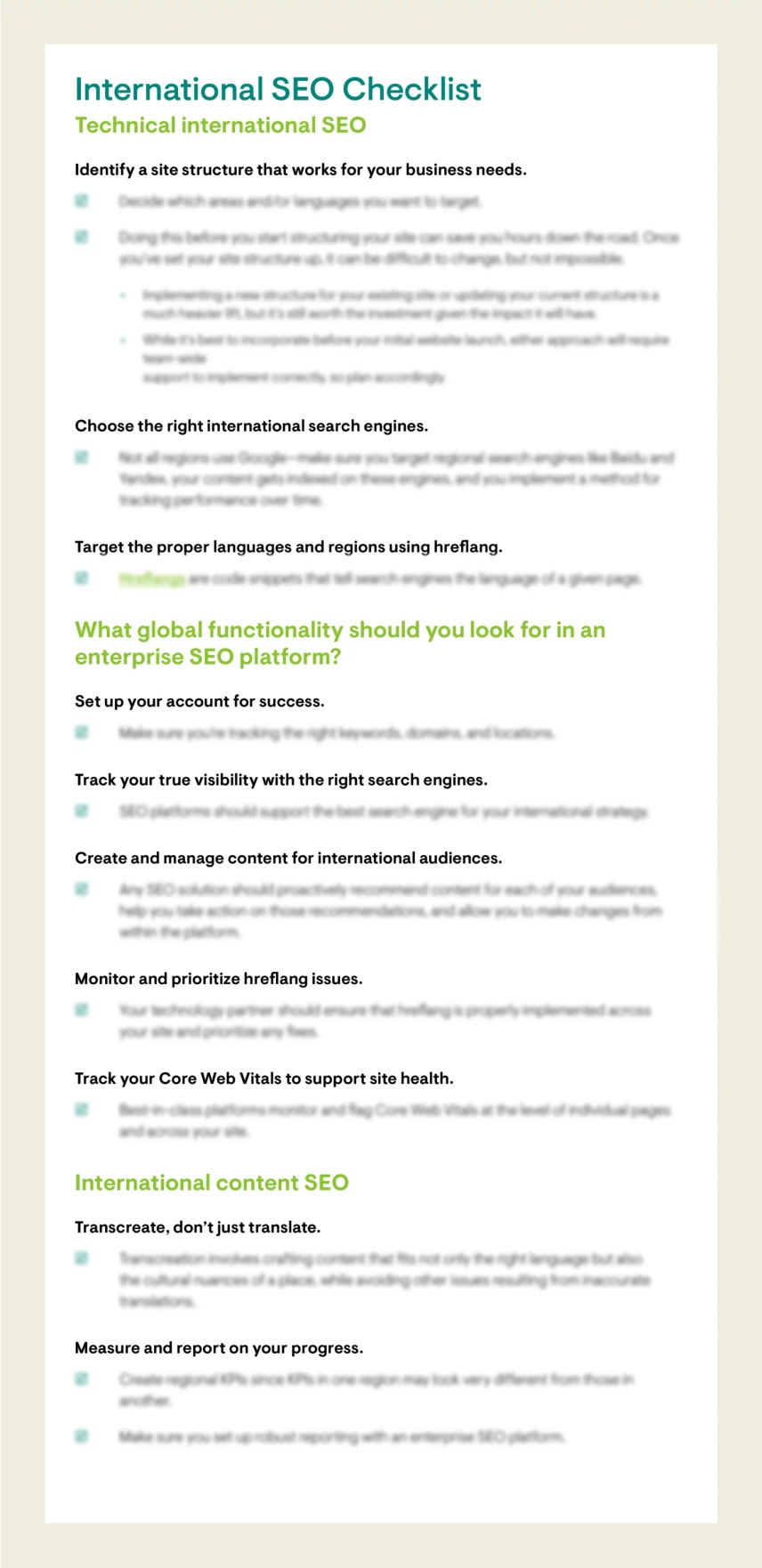How to Develop an International SEO Strategy
International SEO refers to optimizing your search presence for different languages and countries. Use this guide to implement your global SEO strategy.
For some reason, when people think about international SEO, they think it's all about launching sites with translated content, implementing hreflang, and that's it.
The truth of the matter is: they're wrong. International SEO goes way beyond that.
In this article, we'll explain why international SEO is important, and how to leverage it successfully to overtake your competitionCompetition
Businesses generally know who their competitors are on the open market. But are they the same companies you need to fight to get the best placement for your website? Not necessarily!
Learn more.
What is international SEO?
Let's first get our lingo right and define what international SEO is.
International SEO is the process of optimizing your website(s) to drive organic traffic from
- multiple regions (called multiregional SEO)
- and/or languages (called multilingual SEO).
If you're catering to people in Canada with an English and a French website, you're doing multilingual SEO.
If you're catering to people in the US, Canada, UK, and Australia in English you're doing multiregional SEO.
You can combine multilingual and multiregional SEO. For example: you could be catering to people in Canada in English and French, French people in France, and French speaking people in the Flanders region of Belgium.
Before we continue, let's briefly recall what the end goal of doing SEO is: driving organic traffic that has a high potential to convert.
That last bit is important, as that's the reason why loads and loads of SEOs leave money on the table when doing international SEO. If you want to rake in some of that money, keep on reading!
Why should you care about international SEO?
International SEO can be a great way to grow a business, because international SEO may very well be in your competition's blind spot.
In our own example for instance, borders don't matter. Everyone who wants to monitor their website for on-page SEO changes and issues in real time can use ContentKing. Whether they are in Brazil, the United States, Japan, or Italy, it doesn't matter.
For us, international SEO is a no-brainer.
As you may know, the SEO tool space is highly competitive. But, because of our international SEO strategy, we've managed to quickly gain market share by focusing on markets the existing players in the SEO tool space aren't focusing on. The lesson here is: pick your battles!
Another example: one of our customers sells bicycles and bicycle parts online. As they're a Dutch company, they started out catering to the Dutch market. Soon, they saw the huge potential to start selling across borders, so they set up an English website focused on the English speaking markets. Organic traffic started coming in. From the United States, United Kingdom, and even as far as Australia. (This presents all sorts of new challenges, but we'll get to that later.)
The takeaway here is: this business saw an opportunity. They gave it a shot with a relatively low investment, and they validated their gut feeling—there was a huge demand. They had the ambition and the right background (The Netherlands—a typical cycling-centric country). And they took Nike's mantra to heart: they just did it.
It's about much more than just translating content
OK, now it's time to burst one bubble: international SEO is about far more than just translating content.
Remember, SEO is about driving organic traffic that's likely to convert. You're in this to make money, so you need to ensure your target audience feels at home when they land on your site, because you want them to convert and spend money.
International SEO is a combination of doing SEO as you're used to, while reflecting cultural differences.
In order to do international SEO well, you need to localize rather than just translate: you need to enable your target audience to make purchases in their currencies and in their language, and address them the right way, in their cultural context. If you're selling physical goods, such as shoes, think about the different measurement systems. If you're listing dates and times, use the right format in their locale.
If they have questions, communicate with them in their language. Depending on your business area and the audience you're serving, you may even need boots on the ground.
International SEO is all about offering your target audience a pleasant experience on your site. In order to succeed at international SEO, you need to have strong empathy. You need to really get to know your target audience.
If you make them feel at home, they will convert.
How do search engines determine your intended audience?
In an ideal world, search engines would always rank your site for your intended audience. Unfortunately, we don't live in an ideal world, and search engines need hints as to what audiences you're catering to.
In order to understand this better, it's important to go through the most common and meaningful hints:
- Content analysis: what language is it written in? Localization is key here; for example British English is different from American English.
- Domain hints: are you using a
ccTLD, such as.de? If that's the case, search engines will assume it's likely you're targeting Germany. Jump down to domain structure. - Backlink profile: where are your backlinks primarily coming from? Say a website is getting most of its backlinks from domains with the
.de ccTLDand German content—it's likely the website will be associated with the German market. - Hreflang hints: whether or not you're using
hreflangto communicate what audiences you're targeting. Jump down to hreflang. - Content‐language HTML attribute: while Google and Yandex support hreflang, Bing and Baidu don't. Instead, they use the content-language HTML attribute for hints about the intended target audience.
- Webmaster tools: configured language and/or geo targeting in Google Search Console and geo targeting in Bing Webmaster Tools. Jump down to configuring language and geo targeting using webmaster tools.
- Business listings: Google My Business listings and Bing's Places for Business.
International SEO strategy: 8 steps to success
Have we piqued your interest in international SEO? Do you want to explore what it has to offer you?
Follow these 8 steps to compose a winning international SEO strategy:
- Do market research
- Get buy-in for international SEO roll-out
- Research the best way to cater to your audiences
- Define how you'll be managing your SEO
- Do full-blown keyword research
- Create a keyword strategy
- Define how your localization process works
- Create a link building strategy
Step 1: Do market research
If international SEO sounds appealing, it's time to do market research and build a business case. To do so, work through these steps:
- Define which audiences may be interested in your product or service
- Define what's important to effectively cater to these audiences
- Research how these audiences typically find products and services
- Do limited keyword research
- Do competitor research
- Define what you need to do to get started
- Choose what audiences you're interested in catering to first
Define what audiences may be interested in your product or service
Ask around within the company, listen to your gut feeling, but above all: check your analytics data to see if you're already getting traffic and conversions from audiences that you're not actively targeting at this point.
Define what's important to effectively cater to these audiences
What are these audiences' key drivers when they're orienting themselves and making purchases?
Things to consider:
- Having a ccTLD (e.g.
example.de). - Having truly localized content—not just text but also visuals.
- Having local prices, and enabling payments in local currencies.
- Having local live chat.
- Having a local phone number visitors can call.
- Presenting social proof from local companies (e.g. case studies and reviews).
- Whether or not you're going to offer all of your products and services to all audiences. If you're selling heavy products, it may not make sense to ship them all over the world.
Here's an illustration: the Dutch are often fine with navigating an English website with prices in US Dollars, but that's totally different in Germany and France.
Please note that there may be legislation in place relating to your product or service, or the country you're looking to cater to. If you're selling health products or food online, you need to look into what you can and can't do.
And then there's GDPR and other data protection related issues to consider. If you're a US based company looking to get customers in Europe, it's essential to look into this.
Research how these audiences typically find products and services
Keep in mind: not everyone uses Google, and certainly not everyone's on Facebook, Instagram, and Twitter.
To give you some ideas:
- In Germany, physical magazines are still very popular in certain niches.
- Baidu is the most popular search engine in China. The WeChat platform is massively popular in China as well. If you're an eCommerce business considering moving into the Chinese market, then you need to think about WeChat too.
- Yandex is the most popular search engine in Russia, and chat apps like Telegram are massively popular for discussing all sorts of topics.
- Seznam has a sizable market share in Czech Republic.
Keep in mind that other search engines work differently than Google. Different ranking factors will apply, so take that into account.
Do limited keyword research
Because keyword research is a very time-consuming effort, do the minimum needed to have enough data to build your business case.
Do competitor research
What's the competition like? And what edge do you have over them?
This goes beyond SEO.
Look into your future competitors and gauge their performance when it comes to:
- SEO and Content Marketing
- Paid advertising
Are your offering products or services that they don't, or can't? For an eCommerce business: can you offer competitive shipping rates?
Feels a lot like traditional competitor research, right? That's because it is. Moving into a different market isn't an SEO decision.
Define what you need to get started
What do you need in order to get started? Having a localized website is one thing you need for sure, but what else? Do you need to buy domain names, for example, or can you continue using your existing domain name?
If you're offering services, and you're going after a region's enterprise market, you may need an office there with sales staff.
If you're an eCommerce business, depending on the country, all you may need is a localized website and a local phone number. But you may very well also need a local return address (to prevent scaring people off by making them think they'll need to pay huge product return fees), localized support (remember that pleasant experience?), and a local bank account (people may be scared they'll pay high fees for currency conversionConversion
Conversions are processes in online marketing that lead to a defined conclusion.
Learn more / international bank transfers).
Choose what audiences you're interested in catering to first
International SEO can be a multi-stage roll out. We recommend starting out catering to one new audience to gain experience with international SEO, and taking it from there. This will help you get momentum for future endeavors within your organization as well.
Step 2: Get buy-in for international SEO roll-out
Once you have your business case ready, you can start warming your people up to the idea of international SEO.
When selling international SEO internally, it's essential to educate as you sell (similar to pitching SEO).
While they can seem like no-brainers, here are some key things to make clear:
- You can't make do with half your defined budget. If there is not enough budget, and you can't give international SEO a fair shot at success, you should consider not going ahead with it at all. You need to gain sufficient momentum—especially if you need this momentum to internally sell rollouts to even more countries.
- International SEO is about a lot more than just translating keywords from one language to another. Understanding context is key. Make them understand international SEO is a way of thinking, not just slapping on a subfolder with translated content.
Step 3: Research the best URL structure to cater to your audiences
Research what the best way is to appeal to your audiences. A good URL structure inspires confidence and trust.
Do your audiences require the use of ccTLDs? Or can you keep using your existing domain name and work with subfolders instead? Are there technical limitations that prevent you from going this route—making subdomains perhaps the next best thing?
Here are the most common options:
- Country code top-level-domains (ccTLDs for short)
Example:example.de - ccTLDs or global top-level-domains (gTLDs for short) in combination with subdomains
Example:de.example.com - ccTLDs or gTLDs in combination with subfolders
Example:example.com/es/ - ccTLDs or TLDs with a combination of subdomains and subfolders
Example:es.example.com/es-mx/
Each option has its pros and cons. Use the table below to guide your decision.
Method | Pros | Cons |
|---|---|---|
ccTLDs | - Great for click-through rates | - Expensive |
Subdomains | - The "next best thing" after ccTLDs because it's easier to organize and manage than subfolders | - Not great for click-through rates |
Subfolders | - You benefit from domain authority synergy | - Not great for click-through rates |
The shorter the better
When it comes to URLs, and by extension domain names: the shorter the better!
Examples:
apple.comnetflix.com
Consider a short modifier or new TLD
If you want to go for the ccTLD option, but not all your desired domain names are still available you can consider a short modifier to your domain names. The popular app Pocket did this by choosing the domain name: getpocket.com.
Alternatively, you can use one of the new TLDs such as .io, .me, .dev, and .tech.
As noted at the start of this section, keep in mind that URLs need to inspire confidence, so having a recognizable TLD is important. If you decide to choose one of the new TLDs, make sure to choose one that's popular.
Prevent domain names with dashes
Domains with dashes, such as some-domain-name.com, aren't great. They don't inspire a lot of confidence in quality, due to their misuse back in the days when exact matching domains (domains that match search queries exactly) had a big natural advantage.
Step 4. Define how you'll be managing your international SEO strategy
Define how you'll be managing your international SEO strategy, while keeping the future in mind. You don't want to paint yourself into a corner. Also, don't bring two captains onto one ship.
Often we see an approach where the SEO team at the head office is responsible for defining the international SEO strategy, while local teams are responsible for executing it.
Step 5: Do full-blown keyword research
Continue with the keywordKeyword
A keyword is what users write into a search engine when they want to find something specific.
Learn more research you've already done in step 1. Focus on the audiences you'll be catering to first.
Don't just translate keywords
Keep in mind that keywords often don't translate 1-on-1. Sometimes when just translated, these words mean completely different things.
This is where you have to partner with someone who can tell you the audience's context.
To name two examples: they can explain what slang the audience hears and whether your words have multiple meanings.
Step 6: Create a keyword strategy
Use the keyword research you did in step 5 to create a keyword strategy.
Your keyword strategy defines what content you need to create to start ranking for the keywords you're pursuing. You can read more about here.
Step 7: Define how your localization process works
Your keyword strategy describes the content you need to write, but before you can start with that, you need to define what your localization process will look like.
Things you need to consider are:
- How are you going to ensure the same words are used consistently in all of the content? This is important for your keyword strategy, but also from a user point of view. You don't want them to read word A in one text, and word B in another text, when you're talking about the same thing.
- How are you going to manage the localization process? (Tools like Trello or Google Spreadsheets are great to start with.)
- Who will be proofreading and checking the localized content?
- Besides text, do you also need localized visuals and videos? If yes, who will create them?
- How will you address your audience? Is it appropriate to address them informally?
- What constraints are there for a page's title and meta description?
- And the same for Open Graph and Twitter Cards.
Step 8: Create a link building strategy for each market
Unless you're a large, established brand already, you're not going to get many links organically. This usually means that you need to have a strategy to gain links (and actively work on gaining those links). We call this a link building strategy.
You need to create one for each market. Each market works in a (slightly) different way, so the ways to gain links will be different as well. One tactic may work great in market A, but not result in any links in market B.
International SEO best practices
In the previous section we discussed your international SEO strategy; now let's focus on the best practices when it comes to international SEO. These are more tactical in nature and address common mistakes.
Use dedicated URLs for each localized content variant
Serve each localized content variant using a dedicated URL.
Don't use localization parameters in URLs or browser settings to serve a localized version. You don't want there to be any confusion about what URL is meant for what localized content variant, and you want to be able to use the hreflang attribute, so using a dedicated URL for each content variant is the best way to go.
Another reason for not using localization parameters in URLs: you can't use webmaster tools to define the intended audience, because they don't support this option.
Don't auto-redirect
Don't automatically redirect visitors and/or search engines based on their IP addresses, or browser settings. It's annoying for users and can be very confusing for search engines too. It can even cause visitors and search engines to never find certain content!
If you want to actively let visitors and search engines know about an alternative version of a page, show a banner at the top or bottom of the page with a message like:
This page is also available in $otherLanguage.
Also, consider adding links to different localized versions of the content at the bottom the page.
Please note that we often hear about issues where automatic redirects are wreaking havoc. It's risky business. Lots of CMS plugins, for instance, have support for automatic redirection based on perceived location or browser language—and some even have this option turned on by default. Keep this in mind when dealing with issues like these.
It gets even more interesting when only Google, and no other search engines, is having trouble indexing a website. The reason for that could be Google's support for rendering pages while executing JavaScript in the process. As most plugins use a JavaScript redirect, Google would see the redirect*, whereas most other search engines wouldn't, as they don't render pages (yet).
Please note that Bing renders pages as well, but on a much smaller scale than Google, so the chances that they're picking up on the redirects are slim.
- Location redirection gone wrong .
- *: Google would eventually see the redirect, but it can take quite a long time before they do. Read here to learn why that is.
Don't use cloaking
CloakingCloaking
Cloaking is a method which gives search engines the impression that a website carries content that is different to what users actually see.
Learn more refers to serving different versions of content to users and search engines. This is a popular practice among black-hat SEOs to mislead search engines.
For example, they'll feed search engines keyword-rich content that's barely readable for visitors. At the same time, they'll serve a much more readable version to visitors.
In international SEO cloaking is sometimes used as a solution to present auto-redirect to users, but not search engines. As we've covered in the previous section, auto-redirection isn't recommended in most cases anyway, but serving users page A and search engines page B only makes matters worse.
Don't close off your site for part of the world
With the introduction of GDPR, a lot of businesses in the US panicked and made their website inaccessible to European visitors. Sometimes they'd just show a brief message explaining what happened, and sometimes they'd incorrectly use the HTTP status code 451.
Making your site inaccessible to 11% of the world population, which could very well be within your target audience, is generally a very bad idea. Get creative, and just tackle the GDPR concerns and stop limiting yourself.
Don't use automatic translation tools
When localizing websites, don't use automatic translation tools (machine translation). As we mentioned earlier, lots of words don't translate 1-on-1 from one language to another. Aside from that, few translation tools really produce human-readable content.
When doing international SEO, it's essential that you get your target audience's context right. Automatic translation tools are a surefire way to get that part wrong.
This is the kind of translation you want to avoid.
Use the hreflang attribute
The hreflang attribute is used to indicate what language your content is in and what geographical region your content is meant for.
You can implement the hreflang attribute by:
- including it in the
<head>section of your HTML, - including it in your XML sitemap markup, or
- including it in your HTTP headers.
When using the hreflang attribute, stick to these best practices:
- Reference both the page itself and its translated variants.
- Make sure to have bidirectional hreflang attribute references.
- Correctly define language and region combinations.
- Always set
hreflang="x-default". - Ensure that the hreflang attribute and the canonical URL match.
- Use absolute URLs when defining the hreflang attribute.
- Use only one method to implement the hreflang attribute.
While we always recommend using the hreflang attribute, some argue that, if search engines aren't having any trouble ranking the right page for the right audience, adding the hreflang attribute can only cause confusion.
Keep that in mind. SEO is about being pragmatic as well
Defining geo- or language targeting in Bing Webmaster Tools
Aside from hreflang, you can define your preferences regarding your target audience using for example Bing Webmaster Tools.
Use them with caution though, as you can severely limit your site's visibility by configuring your preferences badly.
For example, you've got a Spanish website with domain example.com, and you define that you're targeting Spain in Bing Webmaster Tools. Now your site's visibility outside of Spain—such as in Mexico—will be very limited!
Bing Webmaster Tools
Bing Webmaster Tools lets you define the region preferences only, while choosing to leave the language preferences undefined. Once you've verified a domain, you can do this on a domain, subdomain, subfolder, or even page level.
Please note that it's only recommended to define your preferences in these tools if search engines are having trouble ranking the right page for the right audience. If you're going to use this feature, and you're using the hreflang attribute as well: make sure you're not sending conflicting signals.
Get ready to go global
Global SEO has never been more crucial or more complex. Doing it right will result in a better user experienceUser Experience
User experience (or UX for short) is a term used to describe the experience a user has with a product.
Learn more (happier customers) and improved traffic and revenue (happier executives). In the downloadable eBook, we go into detail about how to improve your international digital strategy with technical international SEO and content SEO best practices. By downloading, you’ll also receive exclusive access to the full International SEO Checklist below—a helpful cheat sheet to set your strategy up for success.

Keep learning about international SEO
We highly recommend checking out Aleyda Solis' Crawling Monday video on international SEO:








